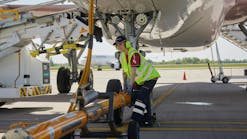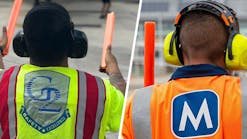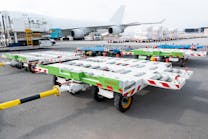Ground Support Worldwide attended the Aviation Fuel Handling Training Symposium, hosted by Gammon Technical Products Feb. 18-20 in Irving, Texas, where industry experts presented to approximately 300 professionals from around the world.
Among the experts was Amy Carico, director of fuel services and technical standards at Airlines for America (A4A), whose presentation "SAF 101 - Introduction to Alternative Jet Fuels and Their Handling" provided an overview of this growing industry. A4A contributed these responses to GSW questions.
GSW: What does the term "SAF" really mean?
A4A: Sustainable aviation fuel (SAF) is one of the many terms describing liquid aviation fuel that emits less carbon on a lifecycle basis than traditional, petroleum-based aviation fuel, while satisfying other relevant sustainability criteria and still meeting the rigorous specifications required to ensure safety of flight.
SAF can be produced from a variety of feedstocks that are coupled with production pathways that use different fuel-processing technologies. Depending on the feedstocks and production pathway, today’s SAF can reduce lifecycle emissions by around 60-80% when compared to conventional jet fuel, with 100% reduction possible in the future.
Jet fuel has always been a complex mixture of hundreds of unique molecules, and each batch is unique, based on the crude slate and refinery processing. Sustainable Aviation Fuel meets the same technical and safety standards as conventional jet fuel. To be used in aircraft today, SAF is blended with conventional jet fuel.
GSW: What is SAF made of?
A4A: SAF can be produced from a number of different feedstocks including oils and fats, oil seed crops, woody wastes, municipal solid waste, CO2 and water.
All SAF that is used in aircraft today is a mixture of a synthetic blend component (SBC) and petroleum-based fuel. SBC, often referred to as neat SAF (not yet blended with conventional jet), is the industry-accepted technical term referring to a finished product meeting one of the ASTM D7566 annexes.
Prior to blending, SBC or neat SAF is not yet approved as a finished fuel and cannot be used in aircraft. It must be blended with conventional jet fuel prior to testing/certification as ASTM D1655 compliant jet fuel.
A mixture of SBC (or neat SAF) with conventional jet fuel creates Semi-Synthetic Aviation Turbine Fuel (SSATF) or Semi-Synthetic Jet Fuel (SSJF). After the SSJF has received one of
several sustainability certifications, it is then deemed and qualified as SAF. These are the industry-accepted technical terms.
Only SSATFs or SAFs that are already blended can be approved as finished fuels, and then be used in aircraft just like any other jet fuel.
GSW: Is there such a thing as fully synthetic aviation fuel?
A4A: Fully synthetic aviation turbine fuel (FSATF) is the industry-accepted technical term for a finished fuel that is made wholly of synthetic components (no conventional jet fuel). These are also commonly referred to as “100% SAF” and have been used on a number of demonstration flights conducted by airlines and OEMs. Because there is not yet an approved ASTM standard for these fuels, they have not yet been used on commercial flights.
FSATFs may contain fuel produced using only a single method of production or may be multiple approved D7566 annexes/production processes blended with each other. FSATFs are molecularly identical to conventional jet fuel and necessarily contain aromatic molecules in order to comply with ASTM D1655.
GSW: What do SAF logistics look like?
A4A: Most SBC or SAF production facilities are not adjacent to standard refining facilities, and SBCs need to be transported to blending facilities before transport to airports.
Pipelines are the safest, most efficient, most economical way to transport liquid fuels. Almost all jet fuel moves by pipeline. Today, no pipelines move SBCs or neat SAFs - only blended SAF can go into a pipeline.
To scale the SAF industry, infrastructure investments across the supply chain are needed. For example, the majority of pre-airfield tanks are not equipped to conduct a proper blend. Expanding the locations where SAF is produced and blended can support the efficient delivery of this fuel to airports.
EI 1533 is a document, produced through collaboration of the world’s leading subject matter experts, containing quality assurance requirements for semi-synthetic jet fuel and synthetic blending components. It defines handling procedures, testing and controls for various types of transportation and equipment used for import, export and shipping of SBC or SAFs. It is the global standard for handling of SBCs and SAF, and can be downloaded here.
GSW: How should SAF be handled at airports?
A4A: SAF requires no special handling, with no special checks or equipment modifications. Once the fuel has met D1655 requirements, it is considered the same as conventional jet fuel.
GSW: What is the industry's goal for adopting SAF usage?
A4A: U.S. carriers transport over 2.6 million passengers and 61,000 tons of cargo per day while contributing just 2 percent of the nation’s greenhouse gas emissions. U.S. operators are committed to achieving net-zero emissions by 2050. Expanding the availability, affordability, and usage of SAF will be essential to reach that goal. U.S. airlines have pledged to work across the aviation industry and with government leaders to make three billion gallons of cost-competitive sustainable aviation fuel (SAF) available for use in 2030. Reaching these goals will require significantly increased commercial scale production and significantly more affordable SAF.
GSW: What do you foresee for the future of SAF usage?
A4A: The SAF industry is still in its infancy. As such, because of the high cost of SAF and the limited production of this fuel, SAF quotas or mandates are not appropriate. But support for voluntary SAF deployment initiatives and incentives can help to scale the growing industry.
SAF must meet rigorous certification and environmental criteria, and there are currently very few producers of SAF, so the costs are very high while logistics for feedstocks, production, blending and delivery are still being established. Scaling this industry will require continued policy support and stakeholder engagement to ensure that SAF is both affordable for airlines and profitable for fuel producers.
U.S. airlines are committed to making SAF commercially viable to support our environmental and supply diversification goals and have engaged with fuel suppliers and other stakeholders to support the nascent industry. There is still significant work to do to scale up supply and make SAF cost competitive with conventional jet fuel.
Accordingly, U.S. airlines welcome support for efforts to make SAF fully commercially viable and deploy SAF where it makes sense as we scale up. U.S. airlines are reaching out to policymakers, renewable fuels producers, and increasingly with the agriculture industry to find ways to more rapidly scale up the availability of affordable SAF. If we are collectively successful, in addition to the environmental benefits, there benefits to be gained for fuel producers, farmers and other feedstock providers, airlines, and the traveling public, We encourage fuel producers, airports, policymakers, environmental organizations and other stakeholders to work with us in cooperative ways to develop, evaluate and support policies that will, quite literally, get SAF off the ground.






